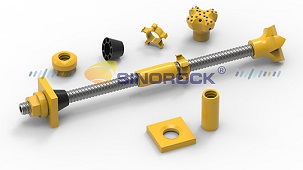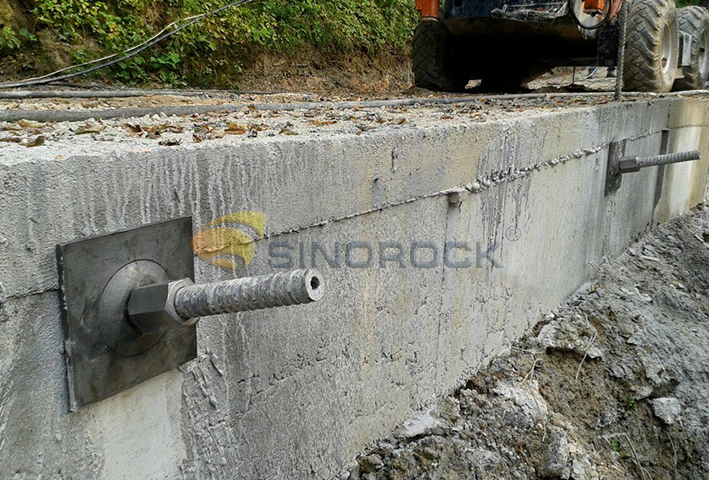How to Deal with Easy-to-collapse Formations? Self Drilling Anchor Bolt Construction Guide
Time:2023-04-28From:sinorock View:
With the development of economy and society, the degree of development and utilization of underground space is increasing, and the scale and depth of various deep foundation projects are increasing. At present, new technologies and techniques of foundation support emerge in an endless stream, but the pile-anchor support form is still one of the widely used support forms. After long-term engineering practice, ordinary prestressed anchor bolts have mature technology, reliable technology, convenient construction, and low cost. They are currently widely used. However, under some complex geological conditions, such as filling and soft soil, there may be holes and necking. Insufficient anchor rod length, poor grouting effect and other problems lead to increased construction difficulty and even affect the safety of the support structure and the stability of the slope. So how to deal with these complex and easy-to-collapse formations, the following will answer your questions.
Types and Characteristics of Common Collapse Strata
1. Soft soil and other easy-to-collapse formations
In soft soil, newly accumulated backfill soil and newly deposited loose fine sand soil layer, if the groundwater level is high, even if the borehole is protected by mud, it is difficult to maintain the stability of the hole wall, and it is easy to cause collapse. Because this type of formation is mostly distributed in the shallow layer of the ground surface, with the gradual increase of the amount of landslides, the ground around the borehole will collapse, often causing the casing to sink. In severe cases, it will also pose a threat to drilling equipment and operators.
2. Sand and silt strata
When drilling holes in fine sand or silt layers, if the groundwater level is high, it is necessary to use mud to form holes in the retaining wall. Due to the lack of cohesive force between particles, this type of formation is easily scoured under the action of water flow. The sand particles scoured by the hole wall further reduce the wall protection effect of the wall protection mud. It is more likely to cause problems such as neck guards and even collapsed holes.
3. Gravel layer, pebble layer
It is very difficult to drill holes in sand, gravel, pebble and broken zone formations. Such formations are called mechanical dispersion formations. Due to the lack of cementation between the particles, the hole walls are prone to collapse during drilling. For such formations with mud or high-viscosity slurry wall protection, the key to solving the problem is to increase the cementation force between the well wall particles. Appropriate infiltration of dry slurry into the double-wall formation can significantly enhance the cementation force between sand and gravel, thereby enhancing the stability of the hole wall.
4. Dissolution formation
Dissolution formations are most typical of sodium chloride salt formations, and others include potassium salts, gypsum, Glauber's salt, trona, etc. This kind of stratum is also called water-soluble stratum. They will dissolve when encountering the water in the pore-forming fluid, and the pore wall will be dissolved away. As a result, the pore diameter is often oversized and collapsed.
.jpg)
Introduction of Self-drilling Anchor Bolt
The self-drilling anchor combines drilling, grouting, and anchoring into one process. It can be cut or lengthened arbitrarily according to the needs of the project, and the construction is very convenient. The use of hollow thick-walled steel pipes of equal cross-section instead of steel bars can ensure the tensile strength of the bolt. Grouting through the anchor bar body can improve the grouting density of the bolt, thereby improving the grip force between the rock bolt and the rock and the durability of the rock bolt. The self drilling anchor bolt system has the characteristics of fast construction speed, large anchoring force, good anti-corrosion performance, light weight, simple operation, and can provide anchoring force in time. It is especially suitable for weathered rock, crushed stone layer, backfill layer, gravel layer and other stratum working faces that are difficult to make holes but need to be supported in time.

Self-drilling Anchor Bolt Construction Guide
1. Preparation before construction: Check whether the functions of the drilling rig are normal, whether the drill bit and the rod body are damaged, and whether the anchor bar is unblocked, etc. After ensuring that there is no problem, thread the hollow anchor body to the drill bit;
2. Drilling and grouting: Connect the hollow anchor bar and the grouting pipe to the drilling rig through the rotary grouting adapter, and perform grouting during the drilling process to achieve simultaneous completion of drilling and grouting;
3. Extension anchor bolt: If the length of a single self-drilling anchor bolt does not reach the design drilling depth, the length of the extension coupler can be used to meet the design requirements;
4. Install plates and nuts: After the grouting is completed, install plates and nuts in sequence on the part of the self-drilling anchor bolt exposed outside the rock close to the construction surface to ensure the anchoring effect.

Summary
The characteristics of loose soil and insufficient bearing capacity of the mud-and-rock stratum have caused a series of difficulties for pile foundation construction. When encountering weak strata such as mud and stone, according to the actual situation, comprehensively consider various factors, choose safe, economical and effective treatment methods, achieve early prevention, take measures in place, solve in time, and have obvious effects, so as to ensure pile foundation construction quality. If you have any problems during construction, please don’t hesitate to contact sinorock for bolting solutions at sinorock@sinorockco.com.
latest news
-

- What Are the Applications of SDA Bolts in Hydropower Stations?
- Time:2025-08-21From:This Site
- Learn how self-drilling anchor bolts enhance slope stability, tunnel support, and dam reinforcement in complex geological conditions at hydropower stations. Optimize hydropower projects with efficient, cost-effective, and eco-friendly solutions.
- View details
-

- Slope Stabilization with SDA Bolts: Benefits & Applications
- Time:2025-08-19From:This Site
- Discover how self-drilling anchor bolts (SDA bolts) provide superior slope stabilization for highways, railways, and tunnels. Learn their key benefits, installation process, and real-world applications in loose or collapsible soils.
- View details
-

- How Self-Drilling Rock Bolts Enhance Tunnel Support in Fractured Rock?
- Time:2025-08-15From:This Site
- Discover how self-drilling rock bolts enhance tunnel support in fractured rock. Learn their benefits, installation steps, and real-world applications for safe, efficient tunneling.
- View details
-

- Sinorock 2025 Quality Month | Strengthening Quality Foundations, Empowering Product Excellence
- Time:2025-08-13From:This Site
- Sinorock’s 2025 Quality Month, themed “Strengthening Quality Foundations, Empowering Product Excellence,” successfully concluded, reinforcing our commitment to superior product quality.
- View details
-

- Sinorock Safety Month 2025 | Everyone Speaks Safety, Everyone Can Respond
- Time:2025-07-03From:This Site
- Sinorock Safety Month 2025, centered on the theme "Everyone Speaks Safety, Everyone Can Respond - Spot Workplace Hazards," has wrapped up successfully!
- View details
-

- Quality Control: the Vital Factor of A SDA Bolt Factory
- Time:2025-01-09From:This Site
- Sinorock’s comprehensive quality control system, from supplier management to outgoing inspections, ensuring the highest standards for self-drilling anchor bolts in construction.
- View details
-

- Sinorock Invites You to Explore Proven Self-Drilling Anchor Bolt Solutions at bauma 2025
- Time:2025-03-07From:This Site
- From April 7–13, 2025, explore Sinorock’s Self-drilling anchor bolt solution at Booth C2.513/4 in Hall C2 of the Messe München Exhibition Center (Munich, Germany).
- View details
-
.jpg)
- SINOROCK to Attend EXPOMINA PERÚ 2024 in Lima, Peru
- Time:2024-08-10From:This Site
- Sinorock to Attend EXPOMINA PERÚ 2024 in Lima, Peru
- View details
-
.jpg)
- SINOROCK to Participate in MINING AND METALS CENTRAL ASIA 2024
- Time:2024-08-08From:This Site
- SINOROCK to Participate in MINING AND METALS CENTRAL ASIA 2024
- View details
 Download
Download 


